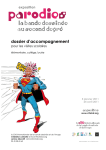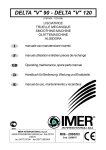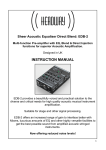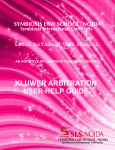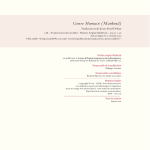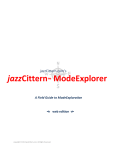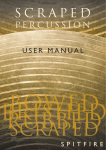Download the CD booklet in PDF format
Transcript
LOREENA MCKENNITT the book of secrets A GOOD TRAVELLER HAS NO FIXED PLANS AND IS NOT INTENT ON ARRIVING. LAO TZU Q R CD 1 0 7 R (570-490 BC) Over a number of years spent ruminating on the distinctive characteristics of the Celts, I began to wonder if their legendarily nomadic ways arose from an inner need; a restlessness that had its roots in an insatiable curiosity. I suspect it was my growing awareness of my own wanderlust that made me aware of the connection I felt to the Celtic lineage. And the more I learned of pan-Celtic culture and its unexpected turns and twists, the more I was drawn to learn about the Celts’ contemporaries, which in turn set me off on tangents which might have little or no connection to the Celts themselves. In casting your inspirational net as an artist, you become familiar with the humility that comes with watching your best-laid plans veer sideways, and recordings becoming something other than what you expected. The journey, not the destination, becomes a source of wonder. In the end, I wonder if one of the most important steps on our journey is the one in which we throw away the map and remember that we are all extensions of our collective history. These songs have been assembled like a mosaic. They are also the souvenirs that come of sifting through shards of history and scraping away layers to reveal the fragile past, as I saw in Italy at an archaeological site at Chianciano Terme where ancient Roman layers reveal even more ancient Etruscan layers, or at the burial site of a mysterious Celtic chieftain in Orvieto. My hope was that this recording might fuel curiosity in the same way as do the best books of travel stories. From all journeys, be they imaginative or geographic, the most important souvenirs to be collected are the reminders that people’s lives are fortified by family and friends; by our ability to create our lives like creating a piece of art; and by our efforts to reconcile our material needs with the importance of our connections to each other. Après de nombreuses années de réflexion sur ce qui caractérise les Celtes, je me suis demandée si leur nomadisme légendaire n’était pas l’expression d’une pulsion; une sorte d’agitation interne qui procède d’une curiosité insatiable. Je crois bien que c’est depuis que j’ai pris conscience et de mon irrésistible envie de voyager que j’ai le sentiment d’appartenir à la descendance celte. Plus j’en apprends sur la culture panceltique, plus je cherche à en savoir davantage sur d’autres peuples du temps des Celtes, ce qui à son tour, me jette sur des pistes qui ont peu ou pas de lien avec les Celtes en tant que tels. L’artiste en quête d’inspiration tend son filet et devient plus humble lorsqu’il voit ses projets prendre une autre tournure et ses enregistrements reproduire une musique différente de celle qu’il imaginait. Le voyage, et non la destination, est source d’émerveillement. Finalement, je me demande si une des escales les plus importantes de notre voyage n’est pas celle où nous jetons notre plan par-dessus bord, de nous rappeler que nous sommes tous le prolongement de l’Histoire de l’humanité. Telle une mosaïque, chaque chanson est comme une collection de petites pièces assemblées une à une. Chaque chanson est aussi une collection de souvenirs, l’essentiel de ce qui reste quand les fragments de l’Histoire sont passés au tamis et que des fouilles sont entreprises pour découvrir le passé couche par couche jusqu’à ce qu’il se révèle à nous dans toute sa fragilité. Ainsi, à Chianciano Terme en Italie, sous les horizons romains d’un site archéologique gisent des horizons étrusques encore plus anciens. Il en est de même du lieu de sépulture d’un mystérieux chef celte à Orvieto. J’espère que cet enregistrement excitera sur votre curiosité comme peuvent le faire les meilleurs livres de récit de voyage. Voyage au coeur de l’imagination ou voyage sur cette terre, l’important est de ne jamais oublier que nos souvenirs les plus chers sont ceux qui nous rappellent les véritables richesses de notre vie: nos parents et amis, nos efforts pour façonner notre vie comme un artiste crée une oeuvre d’art, et les efforts que nous prodiguons à concilier d’une part, la nécessité de satisfaire nos besoins sur le plan matériel avec, d’autre part, l’importance d’entretenir les liens qui nous unissent. MUSIC: LOREENA MCKENNITT 4:22 MUSIC A N D LY R I C : LOREENA MCKENNITT 6:07 OCTOBER 1995, ATHENS: On a trip to the Greek capital, I find that during the course of interviews with local journalists, certain themes arise again and again: people’s spiritual needs, and the time and space needed to nurture that process…One writer mentions a monastery at Mount Athos: a place of reflection but alas, for men only… JANUARY 1, 1985, STRATFORD: I have just read an account of a mumming troupe which boarded a Polish ship stranded in the harbour in St. John’s, Newfoundland, on New Year’s Eve, to entertain the sailors. According to James Frazer in his book “The Golden Bough”, mumming has its roots in the tree-worshipping of the peoples who inhabited great regions of a forested Europe now long gone. JULY 6, 1996, ISTANBUL: One of the organisers of the Istanbul Jazz Festival reminds me that a certain section of the city can be traced back to Celtic roots... In tracing the mosaic of history, I am eager to learn of the influences that come from this place. Mumming usually involves a group of performers dressing up in masks (sometimes of straw) and clothes bedecked with ribbons or rags, and setting out on a procession to neighbouring homes singing songs and carrying branches of greenery. It’s primarily associated with springtime and fertility, and it has a cast of stock characters, like the Fool, which recurs in some form or another from Morris dancing to the shadow puppet plays of Turkey and Greece and even the morality plays of the Middle Ages. 1995, ATHÈNES: Au cours d’un voyage dans la capitale grecque, je réalise que les mêmes thèmes reviennent lors d’interviews avec la presse régionale: la vie spirituelle, l’espace et le temps nécessaires pour méditer les questions qui en émanent... Un journaliste fait référence à un monastère sur le mont Athos: un lieu de recueillement, hélas, réservé aux hommes. MAY 1, 1997, PADSTOW, CORNWALL: As with many time-honoured events, Padstow’s May Day festivities begin the night before. It’s not surprising to find a celebration like this in one of the most historically Celtic corners of England; it begins with a ritual carol, sung a capella, rich with references to springtime and St. George. 6 JUILLET, 1996, ISTANBUL: Un des organisateurs du festival de jazz d’Istanbul me fait remarquer qu’il existe tout un secteur de la ville où on peut remonter jusqu’à des sources celtes. En retracant la mosaïque de l’Histoire, je m’applique à apprendre quelles influences proviennent d’ici. 1ER JANVIER, 1985, STRATFORD: Je viens tout juste de lire l’histoire d’une troupe de momerie qui s’était embarquée sur un navire polonais la veille du jour de l’an pour divertir les matelots. Ce navire s’était échoué au port de St. John’s, à Terre-Neuve. D’après James Frazer et son livre “The Golden Bough”, la momerie est issue des peuples qui vouaient un culte aux arbres et qui habitaient les grandes régions forestières de l’Europe d’antan. OCTOBRE La momerie désigne habituellement une procession de comédiens ambulants vêtus de masques (parfois faits de paille) et d’habits ornementés de rubans et de pièces d’étoffe. Ils défilent devant les chaumières des environs en chantant des chansons et en portant des rameaux feuillus. Surtout associée au printemps et à la fertilité, la momerie possède tout un lot de personnages, comme le bouffon qui revient sous une forme ou une autre dans la danse Morris (un type de danse folklorique anglaise), dans le théâtre d’ombres de la Turquie et de la Grèce ou même encore dans les courtes pièces de théâtre allégoriques du Moyen Âge. 1ER MAI, 1997, PADSTOW, CORNOUAILLES: Comme c’est souvent le cas lors d’événements consacrés par la tradition, à Padstow, les festivités de la Fête du travail démarrent la veille au soir. Il n’est pas étonnant qu’une telle fête soit célébrée dans l’une des premières enclaves celtes d’Angleterre. La veille du Premier Mai, on commence la fête en chantant a cappella un air rituel qui comporte de nombreuses références au printemps et à Saint Georges. When in the springtime of the year • When the trees are crowned with leaves When the ash and oak, and the birch and yew • Are dressed in ribbons fair When owls call the breathless moon • In the blue veil of the night The shadows of the trees appear • Amidst the lantern light We’ve been rambling all the night • And some time of this day Now returning back again • We bring a garland gay Who will go down to those shady groves • And summon the shadows there And tie a ribbon on those sheltering arms • In the springtime of the year The songs of birds seem to fill the wood • That when the fiddler plays All their voices can be heard • Long past their woodland days And so they linked their hands and danced • Round in circles and in rows And so the journey of the night descends • When all the shades are gone “A garland gay we bring you here • And at your door we stand It is a sprout well budded out • The work of Our Lord’s hand” MUSIC A N D LY R I C : LOREENA MCKENNITT 6:07 SEPTEMBER 13, 1995, TUSCANY: I have been reading Thomas Cahill’s book “How The Irish Saved Civilization”, with its lively account of Irish monks in the so-called Dark Ages. Monasteries were often founded in harsh, remote outposts like the Skellig Islands off Ireland’s west coast. SEPTEMBER 20, 1995, ITALY: “They change their sky but not their soul who cross the ocean.” I set out for Bobbio in Emilia-Romagna, which Cahill says was the first Irish monastery to be established in Italy when renegade Irish monks were banished to the continent. How strange it was to view these very early Irish times in the museum at Bobbio and see the name of Saint Columbanus. 13 SEPTEMBRE, 1995, TOSCANE: Je lis le livre de Thomas Cahill, “How the Irish Saved Civilization”, qui comporte un récit coloré sur les moines irlandais du Moyen Âge, période soi-disant sombre. Des abbayes étaient souvent fondées dans des coins où le climat était fort rude, notamment dans les îles Skellig au large de la côte ouest de l’Irlande. 20 SEPTEMBRE, 1995, ITALIE: “Ils changent leur firmament, pas leur âme qui traverse l’océan.” Je suis partie pour Bobbio, en Émilie-Romagne. Cahill la désigne comme étant la première abbaye irlandaise à être fondée en Italie à une époque où les moines apostats irlandais étaient bannis au continent. C’est étrange de pouvoir contempler l’histoire ancienne de l’Irlande au musée de Bobbio, en Italie, et même d’y voir le nom de Saint Columbanus. O light the candle, John • The daylight has almost gone • The birds have sung their last • The bells call all to mass Sit here by my side • For the night is very long • There’s something I must tell • Before I pass along I joined the brotherhood • My books were all to me • I scribed the words of God • And much of history • Many a year was I • Perched out upon the sea • The waves would wash my tears; • The wind, my memory I’d hear the ocean breathe; • Exhale upon the shore • I knew the tempest’s blood • Its wrath I would endure And so the years went by • Within my rocky cell • With only a mouse or bird • My friend; I loved them well And so it came to pass • I’d come here to Romani • And many a year it took • Till I arrived here with thee On dusty roads I walked • And over mountains high • Through rivers running deep • Beneath the endless sky Beneath these jasmine flowers • Amidst these cypress trees • I give you now my books • And all their mysteries Now take the hourglass • And turn it on its head • For when the sands are still • ‘Tis then you'll find me dead O light the candle, John • The daylight has almost gone • The birds have sung their last • The bells call all to mass MUSIC: LOREENA MCKENNITT 5:15 MUSIC: LOREENA MCKENNITT LY R I C : A L F R E D N O Y E S , A B R I D G E D B Y L O R E E N A M C K E N N I T T 1 0 : 1 9 NOVEMBER 3, 1991, VENICE: This first trip to Venice has been fascinating, not only because of the extraordinary exhibition of Celtic artefacts I have just seen, but because walking through the city itself has heightened my awareness of just how important Venice was as a crossroads between cultures. Threads of history reverberate around me, including the story of Marco Polo, the thirteenth century merchant-adventurer who claimed to have travelled all the way to China. JULY 1993, STRATFORD: Some friends have offered the suggestion that I set Alfred Noyes’ poem “The Highwayman” to music. This dramatic, tragic narrative, rich with the imagery of 18th century rural England, could be fun to work on at Real World, where the surrounding landscape seems to exude that very atmosphere. MARCH 1997, REAL WORLD STUDIOS: At the beginning and middle of this piece, I have interwoven an authentic Sufi melody that I first heard performed by a group called Ensemble Oni Wytars. The wind was a torrent of darkness among the gusty trees • The moon was a ghostly galleon tossed upon the cloudy seas • The road was a ribbon of moonlight over the purple moor • And the highwayman came riding, • Riding, riding, • The highwayman came riding, up to the old inn-door. 3 NOVEMBRE, 1991, VENISE: Mon premier voyage à Venise s’avère captivant, non seulement à cause de l’extraordinaire exposition d’objets d’art celtes que je viens tout juste de voir, mais aussi parce qu’en me promenant dans la ville, je réalise que Venise était jadis un véritable carrefour de cultures. Le fil de l’Histoire se déroule devant moi, jusqu’à l’histoire de Marco Polo, le marchand-aventurier du treizième siècle qui affirme avoir voyagé jusqu’en Chine. He’d a French cocked hat on his forehead, a bunch of lace at his chin, • A coat of claret velvet, and breeches of brown doe-skin; • They fitted with never a wrinkle; his boots were up to the thigh! • And he rode with a jewelled twinkle, • His pistol butts a-twinkle, • His rapier hilt a-twinkle, under the jewelled sky. MARS 1997, STUDIOS REAL WORLD: J’ai inclus, au début et au milieu de cette pièce, un air soufi authentique que j’ai entendu pour la première fois joué par l’Ensemble Oni Wytars. JUILLET 1993, STRATFORD: Des amis me suggèrent de composer une chanson à partir du poème d’Alfred Noyes, “The Highwayman”. Ce serait certes intéressant de travailler sur un tel projet aux studios Real World situés dans un cadre qui dègage justement l’ambiance des paysages ruraux de l’Angleterre du XVIIIème siècle qu’évoque si bien le conte à la fois dramatique et tragique de Noyes. Over the cobbles he clattered and clashed in the dark inn-yard, • And he tapped with his whip on the shutters, but all was locked and barred; • He whistled a tune to the window, and who should be waiting there • But the landlord’s black-eyed daughter, • Bess, the landlord’s daughter, • Plaiting a dark red love-knot into her long black hair. “One kiss, my bonny sweetheart, I’m after a prize tonight, • But I shall be back with the yellow gold before the morning light; • Yet if they press me sharply, and harry me through the day, • Then look for me by the moonlight, • Watch for me by the moonlight, • I’ll come to thee by the moonlight, though hell should bar the way.” He rose upright in the stirrups; he scarce could reach her hand • But she loosened her hair i’ the casement! His face burnt like a brand • As the black cascade of perfume came tumbling over his breast; And he kissed its waves in the moonlight, (Oh, sweet black waves in the moonlight!) • Then he tugged at his rein in the moonlight, and galloped away to the West. He did not come at the dawning; he did not come at noon, • And out o’ the tawny sunset, before the rise o’ the moon, • When the road was a gypsy’s ribbon, looping the purple moor, • A red-coat troop came marching, • Marching, marching • King George’s men came marching, up to the old inn-door. They said no word to the landlord, they drank his ale instead, • But they gagged his daughter and bound her to the foot of her narrow bed; • Two of them knelt at the casement, with muskets at their side! • There was death at every window, • And hell at one dark window; • For Bess could see, through the casement, the road that he would ride. They had tied her up to attention, with many a sniggering jest; • They had bound a musket beside her, with the barrel beneath her breast! • “Now keep good watch!” and they kissed her. • She heard the dead man say - • Look for me by the moonlight • Watch for me by the moonlight • I’ll come to thee by the moonlight, though hell should bar the way! She twisted her hands behind her, but all the knots held good! • She writhed her hands till her fingers were wet with sweat or blood! • They stretched and strained in the darkness and the hours crawled by like years! • Till, now, on the stroke of midnight, • Cold, on the stroke of midnight, • The tip of one finger touched it! The trigger at least was hers! Tlot-tlot! Had they heard it? The horse-hoofs were ringing clear • Tlot-tlot, in the distance! Were they deaf that they did not hear? • Down the ribbon of moonlight, over the brow of the hill, • The highwayman came riding, • Riding, riding! • The red-coats looked to their priming! She stood up straight and still! Tlot, in the frosty silence! Tlot, in the echoing night! • Nearer he came and nearer! Her face was like a light! • Her eyes grew wide for a moment! She drew one last deep breath, • Then her finger moved in the moonlight, • Her musket shattered the moonlight, • Shattered her breast in the moonlight and warned him with her death. He turned; he spurred to the West; he did not know she stood • Bowed, with her head o’er the musket, drenched with her own red blood! • Not till the dawn he heard it; his face grew grey to hear • How Bess, the landlord’s daughter, • The landlord's black-eyed daughter, • Had watched for her love in the moonlight, and died in the darkness there. Back, he spurred like a madman, shrieking a curse to the sky • With the white road smoking behind him and his rapier brandished high! • Blood-red were the spurs i’ the golden noon; wine-red was his velvet coat, • When they shot him down on the highway, • Down like a dog on the highway, • And he lay in his blood on the highway, with the bunch of lace at his throat. Still of a winter’s night, they say, when the wind is in the trees, • When the moon is a ghostly galleon, tossed upon the cloudy seas, • When the road is a ribbon of moonlight over the purple moor, • A highwayman comes riding, • Riding, riding, • A highwayman comes riding, up to the old inn-door. MUSIC: LOREENA MCKENNITT 5:09 NOVEMBER 3, 1991, VENICE: For a thousand years, the “most serene” and most glittering city of the Adriatic. This is a wonderfully quiet time of the year to explore the city. I walked down the narrow inner streets and canal edges, damp with mist; an unworldly blend of sight and sound. I passed through the city’s ancient Jewish quarter, whose walls hint at a darker side to Venice’s past. JULY 1995, STRATFORD: I have just come across an amazing account of Venice in Jan Morris’ book of the same name. She describes, in delicious detail, the occasion of the young Henry III of France’s visit to the city in 1574. Upon his arrival, he was dazzled by an extraordinary pageant arranged in his honour: barges decorated with triumphal arches; rafts peopled by glass-blowers who created figurines as they floated past; paintings commissioned from masters of the era. 3 NOVEMBRE, 1991, VENISE: La ville la “plus sereine” et la plus chatoyante de la mer Adriatique pendant mille ans. À ce temps-ci de l’année, on peut explorer la ville en toute tranquillité. Je descends les étroites rues intérieures et les bords du canal qui baignent dans la brume. Ce mélange d’images et de sons n’est pas de ce monde. Je traverse l’ancien quartier juif de la ville. Ces murs jettent un ombre sur l’Histoire de Venise. JUILLET 1995, STRATFORD: Je viens tout juste de lire dans le livre Venice de Jan Morris un récit passionant sur cette ville. L’auteur décrit de facon fort savoureusement détaillée la visite du jeune roi de France Henri III à Venise en 1574. À son arrivée, il fut ébloui par l’extraordinare spectacle qui fut préparé en son honneur: des péniches décorées d’arcs triomphals, des radeaux transportant des souffleurs de verre qui soufflaient de petites figures en verre au moment où ils passaient devant le roi, des tableaux peints par les grands maîtres de l’époque. MUSIC A N D LY R I C : LOREENA MCKENNITT 8:30 “Once you have tasted the secrets, you will have a strong desire to understand them” SEPTEMBER 1995, TUSCANY: I have been studying William Eamon’s book “Science And The Secrets Of Nature”, whose look at the history of science touches on how the mysteries of nature gradually became explainable. The book examines how knowledge was manipulated and withheld for the personal advantage of a few, and I am struck by the similarities of the dilemmas facing our present age. FEBRUARY 1996, STRATFORD: I have just finished reading Murat Yagan’s autobiography, “I Come From Behind Kaf Mountain”, which touches on his initiation to the Sufi path via equestrian training. As in the Celtic culture, horses figure prominently amongst his people, the Abkhazians. “Quand vous aurez goûté aux secrets, vous voudrez les pénétrer.” 1995, TOSCANE: J’étudie le livre de William Eamon, “Science And The Secrets Of Nature”, qui traite de l’histoire de la science et de comment, peu à peu, les mystères de la nature ont pu être expliqués à travers les âges. Il est également question de la manipulation et de la diffusion de l’information qui profitaient à un petit cercle d’initiés. Je suis frappée par l’actualité de ces problèmes. SEPTEMBRE FÉVRIER 1996, STRATFORD: Je viens de lire l’autobiographie de Murat Yagan, I Come From Behind Kaf Mountain qui parle de son initiation à la voie du soufisme par l’entraînement hippique. Pour son peuple, les Abkhazes, comme pour les Celtes, les chevaux jouent un rôle très important d’un point de vue culturel. Ride on • Through the night • Ride on • Ride on • Through the night • Ride on There are visions, there are memories • There are echoes of thundering hooves There are fires, there is laughter • There’s the sound of a thousand doves In the velvet of the darkness • By the silhouette of silent trees They are watching, they are waiting • They are witnessing life’s mysteries Cascading stars on the slumbering hills • They are dancing as far as the sea Riding o’er the land, you can feel its gentle hand • Leading on to its destiny Take me with you on this journey • Where the boundaries of time are now tossed In cathedrals of the forest • In the words of the tongues now lost Find the answers, ask the questions • Find the roots of an ancient tree Take me dancing, take me singing • I’ll ride on till the moon meets the sea MUSIC A N D LY R I C : LOREENA MCKENNITT 7:11 DECEMBER 17, 1995, TRANS-SIBERIAN RAILWAY: It is now Day 5 on this train journey across wintry Siberia. Travelling alone, it is strange not to be able to have a conversation with anyone, but one learns how much can be conveyed through actions, body language, a look in the eye… DECEMBER 18, 1995, TRANS-SIBERIAN RAILWAY: Dante’s “The Divine Comedy” keeps running through my mind as I gaze out at the landscape passing before me, thinking of the people who inhabit it and how they share this human condition... How has the West come to this place of transition? Are our lives really what they imagine? 17 DÉCEMBRE, 1995, LA VOIE DE CHEMIN DE FER TRANSSIBÉRIENNE: C’est le cinquième jour de ce voyage en train à travers la Sibérie hivernale. Quand on voyage seule, il est curieux de ne pouvoir parler à personne, mais tant de choses peuvent s’exprimer par le langage du corps, les gestes et l’expression des yeux... 18 DÉCEMBRE, 1995, LA VOIE DE CHEMIN DE FER TRANSSIBÉRIENNE: Je contemple le paysage qui défile devant moi et je ne peux m’empêcher de penser à “La Divine Comédie de Dante”, et aux gens qui habitent ici avec qui nous partageons la condition humaine... Comment l’Occident est-il devenu un tel lieu de transition? Nos vies sont-elles vraiment celles qu’ils s’imaginent? When the dark wood fell before me And all the paths were overgrown When the priests of pride say there is no other way • I tilled the sorrows of stone. I did not believe because I could not see Though you came to me in the night When the dawn seemed forever lost • You showed me your love in the light of the stars. Cast your eyes on the ocean • Cast your soul to the sea • When the dark night seems endless Please remember me. Though we share this humble path, alone How fragile is the heart Oh give these clay feet wings to fly To touch the face of the stars. Cast your eyes on the ocean • Cast your soul to the sea • When the dark night seems endless Please remember me. Breathe life into this feeble heart Lift this mortal veil of fear Take these crumbled hopes, etched with tears We’ll rise above these earthly cares. Then the mountain rose before me By the deep well of desire From the fountain of forgiveness Beyond the ice and the fire. Cast your eyes on the ocean • Cast your soul to the sea • When the dark night seems endless Please remember me • Please remember me. My sincerest thanks to all those listed, for bringing their talents to bear on this project. Special thanks to my colleagues at Quinlan Road Stratford and UK: Rosie Bailey, Ian Blackaby, Jane Boyce, Bill Bruce, Marge Bruce, Alex Bryant, Tim Fowkes, Alan McGowan, Xaine McGowan, Dani Noble, Karen Shook. PRODUCED BY LOREENA MCKENNITT Assistants to the producer: Brian Hughes and Donald Quan • Engineered by Stuart Bruce and Kevin Killen • Tracks 2-8 recorded by Stuart Bruce; Track 1 recorded by Kevin Killen • Tracks 1,2,5,7 mixed by Kevin Killen; Tracks 3,4,6,8 mixed by Stuart Bruce • Assisted by Jacquie Turner, Justin Griffith, Marco Migliara • Recorded at Real World Studios, Wiltshire • Additional mixing at Air Studios, London • Mastered by Bob Ludwig at Gateway Mastering Studios, Inc., Portland, ME. Digitally remastered by Jeff Wolpert and Brian Hughes at Phase One Studios, Toronto. Original design: Margo Chase Design • Additional design: Creative Feats Inc. Photography: Ann Cutting • French translation: Claude Fortin MUSICIANS: LOREENA McKENNITT Vocals: Tracks 1,2,3,4,5,7,8 / Piano: Track 8 / Keyboards: Tracks 1,2,3,4,5,6,7,8 / Harp: Track 6 / Kanoun: Track 1 / Accordion: Tracks 4,5 •ANNE BOURNE Cello: Track 6 • AIDAN BRENNAN Acoustic Guitar: Track 3 / Mandola: Tracks 4,7 • MARTIN BROWN Acoustic Guitar: Track 5 / Mandolin: Track 5 / Mandola: Track 5 • STUART BRUCE Assembled Drone: Track 1 / Vocal Drone: Track 4 • PAUL CLARVIS Snare Drum: Track 5 • NIGEL EATON Hurdy Gurdy: Tracks 2,4 • STEÁFÁN HANNIGAN Bodhran: Track 5 • NICK HAYLEY Serangi: Track 7 / Rebec: Track 7 / Lira da Braccio: Track 7 • BRIAN HUGHES Oud: Tracks 2,4,7 / Electric Guitar: Tracks 1,5 / Acoustic Guitar: Tracks 4,5,7 / Bouzouki: Tracks 4,5,7 / Guitar Synthesizer: Track 4 / Classical Guitar: Track 6 / Vocal Drone: Track 4 • ROBIN JEFFERY Victorian Guitar: Track 6 • MARTIN JENKINS Mandocello: Tracks 3,4,5,7 • MANU KATCHÉ Drums: Tracks: 1,2,4,7 • CAROLINE LAVELLE Cello: Tracks 2,5,8 • RICK LAZAR Percussion: Tracks: 1,2,4,5,7 • JOANNA LEVINE Viola da Gamba: Tracks 3,6 • HUGH MARSH Violin: Tracks 2,3,4,5,6,7,8 • OSAMA Violin: Track 4 • STEVE PIGOTT Additional Keyboards: Tracks 3,8 • DONALD QUAN Tabla: Tracks 2,4,7 / Timba: Track 1 / Esraj: Track 1 / Viola: Tracks 2,4,5,6,8 / Additional Keyboards: Tracks 3,4 / Vocal Drone: Track 4 • HOSSAM RAMZY Percussion: Tracks: 2,4,5,7 • DAVID RHODES Electric Guitar: Track 2 • DANNY THOMPSON Acoustic Bass: Tracks 2,3,4,5,7,8 • BOB WHITE Tin Whistle: Track 3 / Shawm: Track 4 • STRING QUARTET: JONATHAN REES 1st Violin: Tracks 3,7 • IAIN KING 2nd Violin: Tracks 3,7 • ANDY BROWN Viola: Tracks 3,7 • CHRIS VAN KAMPEN Cello: Tracks 3,7 • CAROLINE DALE String Arrangements for Tracks 3,6,7 • Additional String Arrangements BRIAN GASCOIGNE and DOUG RILEY • “Dante’s Prayer” includes an excerpt of “Alleluia, Behold The Bridegroom” from the album Russian Easter performed by the St. Petersburg Chamber Choir and conducted by Nikolai Korniev, courtesy of Philips Classics Productions. • Martin Jenkins appears courtesy of Osmosys Records. • “The Highwayman” by Alfred Noyes used courtesy of John Murray (Publishers) Ltd. Thank you, also, to Dave Tollington, Candy Higgins, Peter Standish, Arlene Grzeszak; to Owen Leech, Natasha White and the staff at Real World Studios; to Terry Stone; to Larry Fisher; to Dorcas Till and Festival Travel; to Jeff Wolpert, John Whynot, Scott Matthews, Paul Benedict and Peter Williams; to Graham Henderson; to Canadian Airlines. Finally, thank you to my mother, who set me out on this path unbeknownst to us both. And, as always, I should add that these projects rely upon the involvement and bountiful efforts of many who have not been named here. My sincerest thanks to all of them as well. A bibliography of the texts used in researching this recording is available from Quinlan Road upon request. Lao Tzu translation copyright © 1988 by Stephen Mitchell. Reprinted with permission from Tao Te Ching: A New English Version by Stephen Mitchell, HarperCollins, 1988. All songs written and/or arranged by Loreena McKennitt. All songs are copyright throughout the world by Quinlan Road Music Ltd. (SOCAN/BMI). In Canada, the United States, Australia and New Zealand, all rights are administered by Quinlan Road Music Ltd. Throughout the rest of the world, all rights are administered by BMG Music Publishing International. &훿 1997, 2006 Quinlan Road Limited. All rights reserved. Unauthorized reproduction, copying and rental of this recording or artwork is prohibited by law and subject to criminal prosecution. Tous droits réservés. Sauf autorisation, la reproduction, la duplication, la location de ce disque et de sa pochette sont interdites sous peine de poursuites judiciaires. Quinlan Road, P.O. Box 933, Stratford, Ontario, Canada N5A 7M3. Made in E-U/Fabriqué en E-U. www.quinlanroad.com ENHANCED CD INSTRUCTIONS WINDOWS: Insert the CD into the CD-ROM drive and the CD should autoload. If the CD does not autoload, run “start.exe” from the root of this CD-ROM. Follow the onscreen instructions. MAC: Insert the CD into the CD-ROM drive. Double click the “Enhanced” icon. Follow the onscreen instructions. No Warranties: The enhanced elements on this CD are provided to the user without warranties, expressed or implied, of any kind. Neither Quinlan Road Limited nor its distributors shall be liable for any actual or consequential damage arising from the use of, or the inability to use the enhanced elements contained on this CD. MODE D’EMPLOI DE L’ÉDITION REVUE ET AUGMENTÉE DU CD Système d’exploitation WINDOWS : insérez le CD dans le lecteur de cédérom de votre ordinateur qui devrait automa- tiquement télécharger les données gravées sur le CD. Si l’ordinateur ne télécharge pas de lui-même ces données, il vous faudra procéder manuellement en exécutant la commande “start.exe” à la source du programme de ce CD-ROM et suivre les directives telles qu’elles apparaissent à l’écran. Système d’exploitation MACINTOSH : insérez le CD dans le lecteur de cédérom de votre ordinateur et double-cliquez l’icône “Enhanced”. Suivez les directives telles qu’elles apparaissent à l’écran. Avis de non-responsabilité: les données de l’édition revue et augmentée de ce CD sont fournies à l’utilisateur sans garantie aucune, expresse ou implicite. Ni Quinlan Road Ltée, ni ses distributeurs, ne peuvent être tenus responsables de tout dommage direct ou indirect résultant de l’utilisation ou de difficultés d’utilisation des données gravées sur ce CD.








